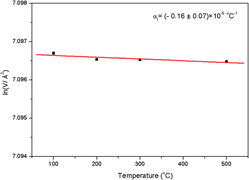Crossref Citations
This article has been cited by the following publications. This list is generated based on data provided by
Crossref.
Zhang, Zhiping
Sun, Weikang
Zheng, Qian
Liu, Hongfei
Zhou, Min
Wang, Wei
and
Chen, Xiaobing
2018.
Tuning the phase transition temperature of Cr2(MoO4)3 by A-site substitution of scandium.
Ceramics International,
Vol. 44,
Issue. 18,
p.
22165.
Costa, Isabella Muller
Blair, Victoria L.
Paraguassu, Waldeci
and
Marinkovic, Bojan A.
2019.
Evaluating Al2-xGaxW3O12 system for thermal shock resistance.
Journal of Solid State Chemistry,
Vol. 277,
Issue. ,
p.
149.
Prisco, Luciana P.
Marzano, Mayara
Pontón, Patricia I.
Costa, Antonio M. L. M.
da Costa Neto, Celio A.
Sweet, Greg
Romao, Carl P.
White, Mary Anne
and
Marinkovic, Bojan A.
2019.
Relationship between sintering methods and physical properties of the low positive thermal expansion material Al2W3O12.
International Journal of Applied Ceramic Technology,
Vol. 16,
Issue. 1,
p.
346.
Madrid, Alison
Pontón, Patricia I.
Garcia, Flávio
Johnson, Michel B.
White, Mary Anne
and
Marinkovic, Bojan A.
2020.
Solubility limit of Zn2+ in low thermal expansion ZrMgMo3O12 and its influence on phase transition temperature.
Ceramics International,
Vol. 46,
Issue. 3,
p.
3979.
Liu, Hongfei
Sun, Weikang
Zhang, Zhiping
Lovings, La’Nese
and
Lind, Cora
2021.
Thermal Expansion Behavior in the A2M3O12 Family of Materials.
Solids,
Vol. 2,
Issue. 1,
p.
87.
Marinkovic, Bojan A.
Pontón, Patricia I.
Romao, Carl P.
Moreira, Thaís
and
White, Mary Anne
2021.
Negative and Near-Zero Thermal Expansion in A2M3O12 and Related Ceramic Families: A Review.
Frontiers in Materials,
Vol. 8,
Issue. ,
Machado, Tamires Martinhão
Muller Costa, Isabella Loureiro
Dosen, Anja
Lima de Faro Melo, Gabriela Salgado
Vasconcellos, Leonardo Ewbank
and
Marinkovic, Bojan A.
2021.
Hygroscopicity, phase transition and thermal expansion in Yb2-Ga W3O12 system.
Journal of Alloys and Compounds,
Vol. 854,
Issue. ,
p.
156643.
Cerón Cortés, Andrés Esteban Cerón
Dosen, Anja
Blair, Victoria L.
Johnson, Michel B.
White, Mary Anne
and
Marinkovic, Bojan A.
2021.
Phase Transition and Coefficients of Thermal Expansion in Al2−xInxW3O12 (0.2 ≤ x ≤ 1).
Materials,
Vol. 14,
Issue. 14,
p.
4021.
de Araújo, Eduardo Viana
da Silva, Marcelo Antonio Santos
de Pereira, Mauricio Sousa
Sombra, Antonio Sérgio Bezerra
de Vasconcelos, Igor Frota
and
Fechine, Pierre Basílio Almeida
2022.
Effect of Bi2O3–B2O3 as a sintering aid in microstructure and dielectric properties of Fe2Mo3O12 electroceramic.
Applied Physics A,
Vol. 128,
Issue. 5,
Romao, Carl P.
Dabkowski, Antoni
Marinkovic, Bojan A.
and
White, Mary Anne
2022.
Thermal properties of single crystals of the low-positive thermal expansion material Al2W3O12.
Solid State Communications,
Vol. 353,
Issue. ,
p.
114873.
